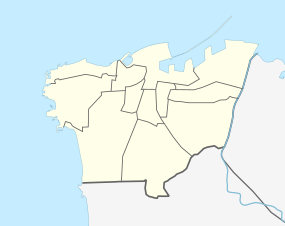Law school of Beirut

The school's exact location is uncertain, but it is thought to have lain just north of Nejmeh Square (pictured), next to the Saint George Greek Orthodox Cathedral.
|
|
| Alternate name | Law school of Berytus |
|---|---|
| Location | Beirut, Lebanon |
| Coordinates | 33°53′46.05″N 35°30′16.24″E / 33.8961250°N 35.5045111°ECoordinates: 33°53′46.05″N 35°30′16.24″E / 33.8961250°N 35.5045111°E |
| Type | University |
| Part of | Colonia Julia Augusta Felix (Berytus) |
| History | |
| Abandoned | A.D. 551 |
| Periods | Late Antiquity |
| Cultures | Roman, Byzantine |
| Associated with | Justinian I, Cyrillus, Patricius, Zacharias Rhetor, St. Pamphilus, St. Triphyllius, Severus of Antioch |
| Site notes | |
| Condition | Not excavated |
The law school of Beirut (also known as the law school of Berytus and the school of Roman law at Berytus) was a center for the study of Roman law in classical antiquity located in Beirut (Latin: Berytus). It flourished under the patronage of the Roman emperors and functioned as the Roman Empire's preeminent center of jurisprudence until its destruction in A.D. 551.
The law schools of the Roman Empire established organized repositories of imperial constitutions and institutionalized the study and practice of jurisprudence to relieve the busy imperial courts. The archiving of imperial constitutions facilitated the task of jurists in referring to legal precedents. The origins of the law school of Beirut are obscure. The earliest written mention of the school dates to 239, when its reputation had already been established. The school attracted young, affluent Roman citizens, and its professors made major contributions to the Codex of Justinian. The school achieved such wide recognition throughout the Empire that Beirut was known as the "Mother of Laws". Beirut was one of the few schools allowed to continue teaching jurisprudence when Byzantine emperor Justinian I shut down other provincial law schools.
The course of study at Beirut lasted for five years and consisted in the revision and analysis of classical juridic texts and imperial constitutions, in addition to case discussions. Justinian took a personal interest in the teaching process, charging the bishop of Beirut, the governor of Phoenicia Maritima and the teachers with discipline maintenance in the school.
The school's facilities were destroyed in the aftermath of a massive earthquake that hit the Phoenician coastline. It was moved to Sidon but did not survive the Arab conquest of 635. Ancient texts attest that the school was next to the ancient Anastasis church, vestiges of which lie beneath the Saint George Greek Orthodox Cathedral in Beirut's historic center.
...
Wikipedia

